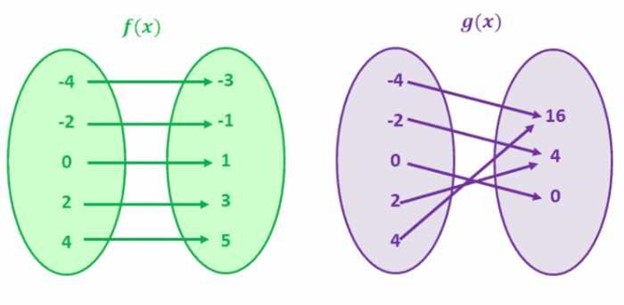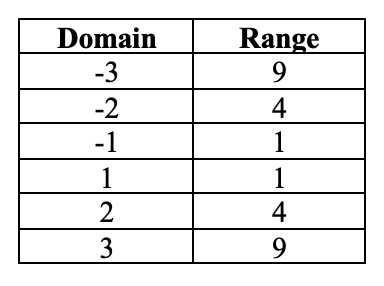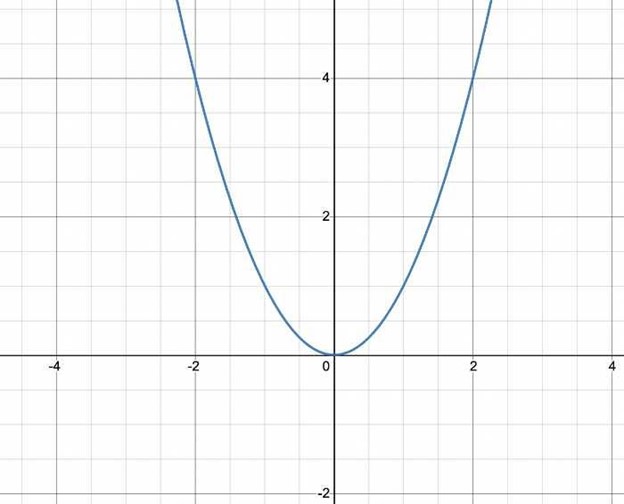One to One Functions - Graph, Examples | Horizontal Line Test
What is a One to One Function?
A one-to-one function is a mathematical function where each input correlates to a single output. In other words, for every x, there is just one y and vice versa. This means that the graph of a one-to-one function will never intersect.
The input value in a one-to-one function is noted as the domain of the function, and the output value is the range of the function.
Let's study the examples below:

For f(x), any value in the left circle correlates to a unique value in the right circle. In the same manner, any value on the right side correlates to a unique value on the left side. In mathematical terms, this implies every domain holds a unique range, and every range owns a unique domain. Thus, this is a representation of a one-to-one function.
Here are some more representations of one-to-one functions:
-
f(x) = x + 1
-
f(x) = 2x
Now let's study the second image, which displays the values for g(x).
Be aware of the fact that the inputs in the left circle (domain) do not have unique outputs in the right circle (range). Case in point, the inputs -2 and 2 have the same output, that is, 4. In conjunction, the inputs -4 and 4 have the same output, i.e., 16. We can see that there are equivalent Y values for multiple X values. Hence, this is not a one-to-one function.
Here are additional representations of non one-to-one functions:
-
f(x) = x^2
-
f(x)=(x+2)^2
What are the characteristics of One to One Functions?
One-to-one functions have the following properties:
-
The function owns an inverse.
-
The graph of the function is a line that does not intersect itself.
-
The function passes the horizontal line test.
-
The graph of a function and its inverse are identical regarding the line y = x.
How to Graph a One to One Function
When trying to graph a one-to-one function, you will have to determine the domain and range for the function. Let's look at a straight-forward representation of a function f(x) = x + 1.

Immediately after you have the domain and the range for the function, you have to plot the domain values on the X-axis and range values on the Y-axis.
How can you tell whether a Function is One to One?
To prove whether or not a function is one-to-one, we can use the horizontal line test. Once you graph the graph of a function, trace horizontal lines over the graph. In the event that a horizontal line intersects the graph of the function at more than one point, then the function is not one-to-one.
Since the graph of every linear function is a straight line, and a horizontal line doesn’t intersect the graph at more than one spot, we can also deduct all linear functions are one-to-one functions. Don’t forget that we do not leverage the vertical line test for one-to-one functions.
Let's look at the graph for f(x) = x + 1. Once you chart the values for the x-coordinates and y-coordinates, you have to review whether or not a horizontal line intersects the graph at more than one point. In this case, the graph does not intersect any horizontal line more than once. This means that the function is a one-to-one function.

On the other hand, if the function is not a one-to-one function, it will intersect the same horizontal line more than once. Let's examine the figure for the f(y) = y^2. Here are the domain and the range values for the function:

Here is the graph for the function:

In this case, the graph intersects multiple horizontal lines. Case in point, for both domains -1 and 1, the range is 1. Additionally, for both -2 and 2, the range is 4. This implies that f(x) = x^2 is not a one-to-one function.
What is the opposite of a One-to-One Function?
As a one-to-one function has just one input value for each output value, the inverse of a one-to-one function also happens to be a one-to-one function. The inverse of the function essentially reverses the function.
For Instance, in the case of f(x) = x + 1, we add 1 to each value of x as a means of getting the output, in other words, y. The opposite of this function will deduct 1 from each value of y.
The inverse of the function is f−1.
What are the properties of the inverse of a One to One Function?
The characteristics of an inverse one-to-one function are no different than every other one-to-one functions. This means that the opposite of a one-to-one function will possess one domain for each range and pass the horizontal line test.
How do you find the inverse of a One-to-One Function?
Figuring out the inverse of a function is simple. You just need to switch the x and y values. For instance, the inverse of the function f(x) = x + 5 is f-1(x) = x - 5.

Considering what we discussed before, the inverse of a one-to-one function reverses the function. Considering the original output value required us to add 5 to each input value, the new output value will require us to subtract 5 from each input value.
One to One Function Practice Questions
Consider these functions:
-
f(x) = x + 1
-
f(x) = 2x
-
f(x) = x2
-
f(x) = 3x - 2
-
f(x) = |x|
-
g(x) = 2x + 1
-
h(x) = x/2 - 1
-
j(x) = √x
-
k(x) = (x + 2)/(x - 2)
-
l(x) = 3√x
-
m(x) = 5 - x
For every function:
1. Identify whether the function is one-to-one.
2. Graph the function and its inverse.
3. Find the inverse of the function mathematically.
4. State the domain and range of every function and its inverse.
5. Apply the inverse to find the solution for x in each calculation.
Grade Potential Can Help You Master You Functions
If you find yourself having problems using one-to-one functions or similar functions, Grade Potential can connect you with a 1:1 teacher who can support you. Our Manhattan math tutors are skilled professionals who support students just like you improve their mastery of these subjects.
With Grade Potential, you can study at your individual pace from the convenience of your own home. Plan a call with Grade Potential today by calling (646) 787-0529 to learn more about our teaching services. One of our team members will call you to better inquire about your requirements to provide you with the best tutor for you!




